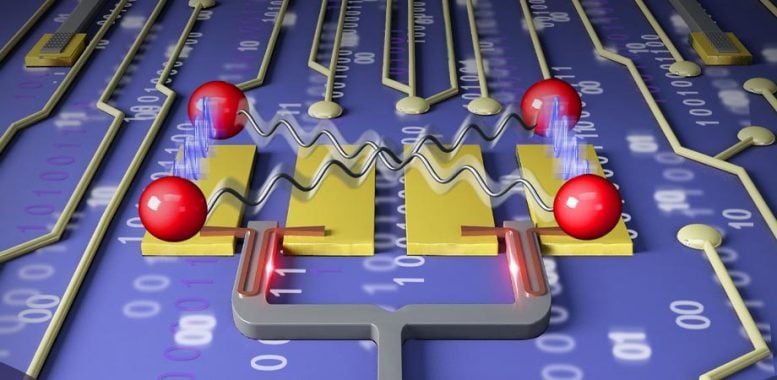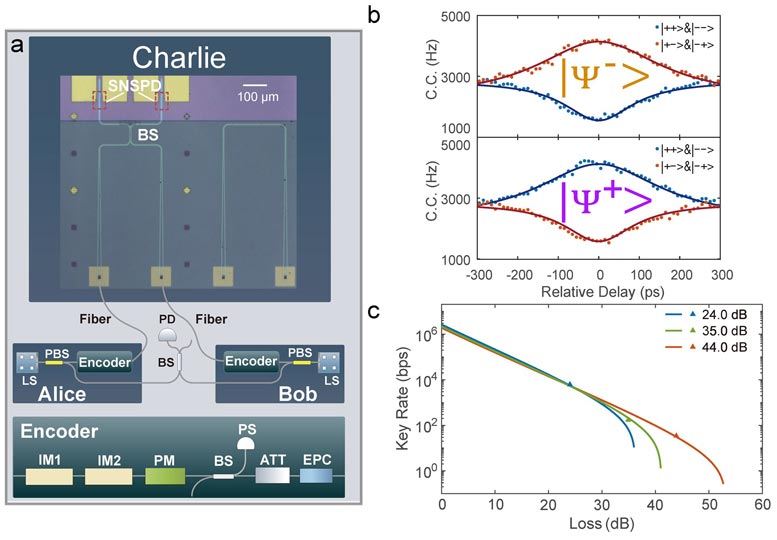
Researchers resolve a long-standing challenge in quantum optics: optimal Bell-state measurement of time-bin encoded qubits, to enhance the key rate of secure quantum communication.
Integrated quantum photonics (IQP) is a promising platform for realizing scalable and practical quantum information processing. Up to now, most of the demonstrations with IQP focus on improving the stability, quality, and complexity of experiments for traditional platforms based on bulk and fiber optical elements. A more demanding question is: “Are there experiments possible with IQP that are impossible with traditional technology?”
This question is answered affirmatively by a team led jointly by Xiao-Song Ma and Labao Zhang from Nanjing University, and Xinlun Cai from Sun Yat-sen University, China. As reported in Advanced Photonics, the team realizes quantum communication using a chip based on silicon photonics with a superconducting nanowire single-photon detector (SNSPD). The excellent performance of this chip allows them to realize optimal time-bin Bell state measurement and to significantly enhance the key rate in quantum communication.
Superconducting Detectors
The single photon detector is a key element for quantum key distribution (QKD) and highly desirable for photonic chip integration to realize practical and scalable quantum networks. By harnessing the unique high-speed feature of the optical waveguide-integrated SNSPD, the dead time of single-photon detection is reduced by more than an order of magnitude compared to the traditional normal-incidence SNSPD. This in turn allows the team to resolve one of the long-standing challenges in quantum optics: optimal Bell-state measurement of time-bin encoded qubits.
This advance is important not only to the field of quantum optics from a fundamental perspective, but also to quantum communications from the application perspective. The team employs the unique advantages of the heterogeneously integrated, superconducting silicon-photonic platform to realize a server for measurement-device-independent quantum key distribution (MDI-QKD). This effectively removes all possible detector side-channel attacks and thus significantly enhances the security of quantum cryptography. Combined with a time multiplex technique, the method obtains an order-of-magnitude increase in MDI-QKD key rate.

Boosting Security and Key Rates
By harnessing the advantages of this heterogeneously integrated system, the team obtains a high secure key rate with a 125 MHz clock rate, which is comparable to the state-of-the-art MDI-QKD experimental results with GHz clock rate. “In contrast with GHz clock rate MDI-QKD experiments, our system doesn’t require a complicated injection locking technique, which significantly reduces the complexity of the transmitter,” says Xiaodong Zheng, a PhD student in Ma’s group and first author of the Advanced Photonics paper.
“This work shows that integrated quantum-photonic chips provide not only a route to miniaturization, but also significantly enhance the system performance compared to traditional platforms. Combined with integrated QKD transmitters, a fully chip-based, scalable, and high-key-rate metropolitan quantum network should be realized in the near future,” says Ma.
Reference: “Heterogeneously integrated, superconducting silicon-photonic platform for measurement-device-independent quantum key distribution” by Xiaodong Zheng, Peiyu Zhang, Renyou Ge, Liangliang Lu, Guanglong He, Qi Chen, Fangchao Qu, LaBao Zhang, Xinlun Cai, Yanqing Lu, Shining N. Zhu, Peiheng Wu, Xiaosong Ma, 30 October 2021, Advanced Photonics.
DOI: 10.1117/1.AP.3.5.055002
Never miss a breakthrough: Join the SciTechDaily newsletter.